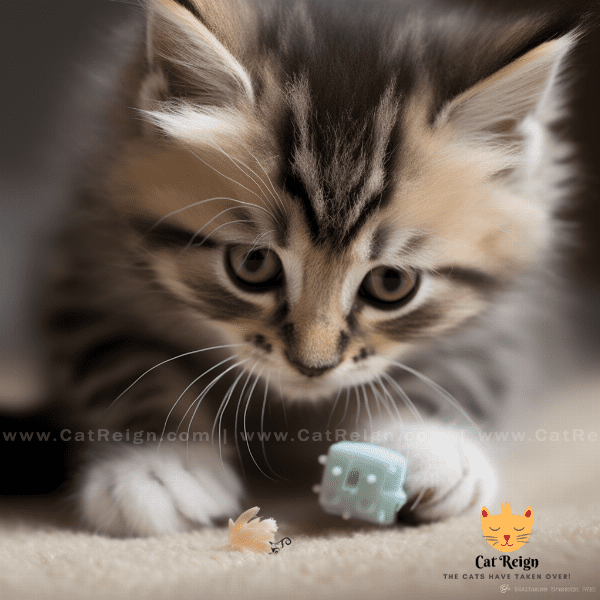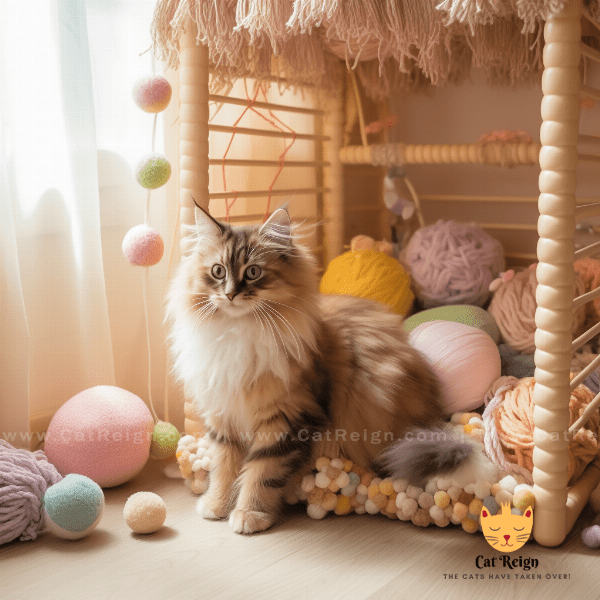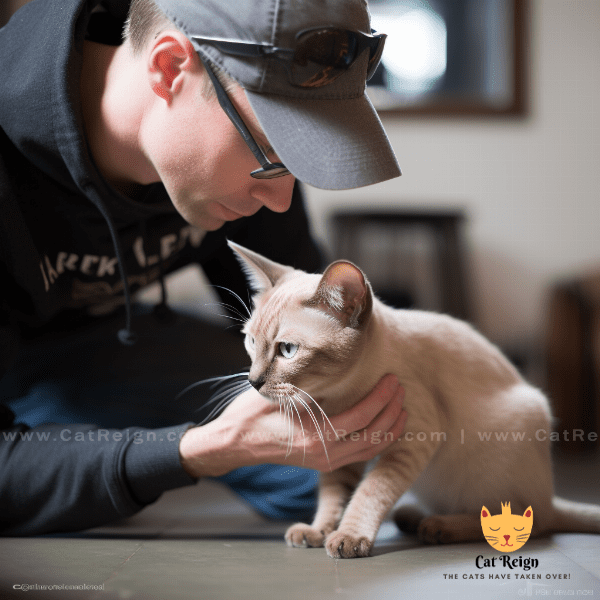Table of Contents
- Understanding Kitten Biting Behavior
- Training Techniques for Stopping Kitten Biting
- Redirecting Your Kitten’s Biting Tendencies
- Creating a Safe Environment for Your Kitten
- Using Positive Reinforcement to Stop Biting
- Consistency in Training for Best Results
- Patience and Persistence: Dealing with Setbacks
- Seeking Professional Help if Necessary
- Providing Alternatives to Biting
- Enjoying a Loving Relationship with Your Kitten
Understanding Kitten Biting Behavior
Kitten biting is a natural and instinctive behavior that is part of their development and play. It is essential to understand why kittens bite before you can effectively stop it.
The Reasons Why Kittens Bite
Kittens use their mouths to explore and understand the world around them. Biting is one of the ways that they explore their environment. Kittens may also bite when they are playing, feeling anxious or scared, or trying to establish dominance. In some cases, kittens may also bite when they are hungry, thirsty, or tired.
The Types of Kitten Biting
Kitten biting can be classified into two types: play biting and aggressive biting. Play biting is a normal behavior for kittens, and it is often accompanied by purring, licking, and other playful behaviors. Aggressive biting, on the other hand, is a serious problem and should be addressed immediately.
When Kitten Biting Becomes a Problem
Kitten biting can become a problem when the bites are too hard and painful, or when the kitten bites too often. This behavior can cause injury, scratches, and infections, and can also be a sign of underlying health issues or emotional distress.
How to Identify Warning Signs
To prevent kitten biting from becoming a problem, it is essential to be able to recognize the warning signs. These may include hissing, growling, arching the back, flattening the ears, or showing teeth. If your kitten displays any of these signs, it is important to stop what you are doing and give them space.
Understanding why kittens bite is the first step towards stopping this behavior. By being patient, consistent, and understanding your kitten’s behavior, you can create a safe and loving environment for your furry friend.

Training Techniques for Stopping Kitten Biting
Now that you understand why your kitten is biting, it’s time to learn how to train them to stop this behavior. Here are some effective training techniques that can help you Stop kitten biting.
Use Deterrents
Deterrents can also be effective in stopping kitten biting. There are several types of deterrents available, including bitter sprays, noise deterrents, and motion-activated devices. These deterrents work by making biting unpleasant for your kitten, discouraging them from biting in the future.
Playtime Limitations
Limiting playtime can also be an effective training technique for stopping kitten biting. Kittens tend to get overexcited during playtime, which can lead to biting. Limiting playtime to short intervals can help prevent overstimulation and reduce the likelihood of biting.
Timeouts
Timeouts can also be an effective training technique for stopping kitten biting. When your kitten bites, say “no” firmly and immediately remove them from the situation. Place them in a separate room for a few minutes, allowing them time to calm down.
Consistency is Key
Stopping kitten biting requires patience, persistence, and consistent training techniques. By using positive reinforcement, deterrents, playtime limitations, timeouts, and consistency, you can train your kitten to stop biting and enjoy a loving relationship with them.

Redirecting Your Kitten’s Biting Tendencies
Redirecting your kitten’s biting tendencies is another effective way to stop them from biting. Here are some helpful techniques for redirecting your kitten’s biting tendencies.
Use Distractions
Using distractions can also be effective in redirecting your kitten’s biting tendencies. When your kitten starts biting, distract them with a toy, a treat, or a game. This will redirect their attention and provide an appropriate outlet for their energy.
Offer Alternatives
Offering alternatives to biting can also be helpful in redirecting your kitten’s biting tendencies. For example, if your kitten is biting your hand, offer them a toy instead. This will help them understand that biting human skin is not acceptable behavior.
Avoid Punishment
Punishing your kitten for biting is not an effective way to redirect their biting tendencies. This can make them anxious, fearful, or aggressive and can worsen the behavior. Instead, use positive reinforcement and redirecting techniques to encourage good behavior.
.

Creating a Safe Environment for Your Kitten
Creating a safe environment for your kitten is important for preventing biting and promoting their overall well-being. Here are some tips for creating a safe environment for your kitten.
Remove Hazards
Kittens are curious creatures and will explore their environment. It’s essential to remove any potential hazards from their environment, such as cords, poisonous plants, sharp objects, or chemicals. Make sure your kitten has a safe and secure space to play and rest.
Provide a Comfortable Environment
Providing a comfortable environment is also essential for your kitten’s well-being. Make sure your kitten has access to fresh water, nutritious food, and a clean litter box. Provide them with a cozy bed, a scratching post, and toys to keep them entertained and engaged.
Socialize Your Kitten
Socializing your kitten is critical for preventing biting and promoting good behavior. Expose them to new people, places, and experiences gradually. This will help them become more confident and less fearful, reducing the likelihood of biting.
Establish Boundaries
Establishing boundaries is also crucial for preventing biting. Teach your kitten what they can and cannot do, such as not jumping on the counter or biting your hands. Be consistent in enforcing these boundaries to prevent confusion and encourage good behavior.
Supervise Your Kitten
Supervising your kitten is essential, especially when they are young and prone to biting. Keep an eye on them and intervene if they display aggressive behavior. This will help prevent injury and promote positive behavior.
Creating a safe environment for your kitten requires careful planning and attention to their needs. By removing hazards, providing a comfortable environment, socializing your kitten, establishing boundaries, and supervising them, you can prevent biting and promote a healthy and happy relationship with your furry friend.

Using Positive Reinforcement to Stop Biting
Positive reinforcement is a powerful tool for stopping kitten biting. Here are some tips for using positive reinforcement to stop biting and encourage good behavior.
Reward Good Behavior
Rewarding good behavior is an effective way to encourage your kitten to behave well. When your kitten refrains from biting, reward them with treats, praise, or affection. This will reinforce positive behavior and encourage them to continue behaving well.
Use Clicker Training
Clicker training is a type of positive reinforcement that uses a clicker to signal to your kitten that they have done something right. When your kitten displays good behavior, click the clicker and give them a treat. This will help them associate the sound of the clicker with positive behavior.
Be Consistent
Consistency is key when using positive reinforcement to stop biting. You must be consistent in your training techniques and follow through with rewards every time your kitten displays good behavior. This will help them understand that good behavior leads to positive outcomes.
Ignore Bad Behavior
Ignoring bad behavior can also be an effective way to use positive reinforcement to stop biting. When your kitten bites, say “no” firmly and turn away from them. This will deny them the attention they are seeking and reinforce that biting is not acceptable behavior.
.

Consistency in Training for Best Results
Consistency is crucial when training your kitten to stop biting. Here are some reasons why consistency is important and how you can achieve it.
Why Consistency is Important
Consistency is essential when training your kitten to stop biting because it helps them understand what behavior is expected of them. If you are inconsistent in your training techniques, your kitten may become confused, leading to frustration and ineffective training. Consistency also helps to reinforce positive behavior and encourage your kitten to continue behaving well.
How to Achieve Consistency
To achieve consistency in your training, it’s essential to establish clear rules and boundaries for your kitten. Decide what behaviors are acceptable and what behaviors are not, and communicate these rules to your kitten consistently. Use the same training techniques every time your kitten displays unwanted behavior, and follow through with rewards or consequences every time. This will help your kitten understand what behavior is expected of them and reduce confusion.
Involve All Family Members
Consistency is also important for everyone in your household who interacts with your kitten. Make sure that all family members are on the same page when it comes to training techniques and rules. This will help avoid confusion for your kitten and reinforce positive behavior consistently.
.

Patience and Persistence: Dealing with Setbacks
Training your kitten to stop biting can be a challenging process, and setbacks are normal. Here are some tips for dealing with setbacks and staying patient and persistent in your training efforts.
Understand the Nature of Setbacks
Setbacks are a natural part of the training process. Kittens may revert to biting behavior when they are feeling anxious, stressed, or overwhelmed. It’s important to understand that setbacks are not a reflection of your training efforts, but rather a normal part of your kitten’s development.
Identify the Cause of Setbacks
To address setbacks effectively, it’s essential to identify the cause. Is your kitten feeling anxious or stressed? Have you been inconsistent in your training techniques? Identifying the cause can help you develop a strategy for addressing the behavior effectively.
Revisit Training Techniques
If you are experiencing setbacks, it may be necessary to revisit your training techniques. Are you using positive reinforcement consistently? Are you providing your kitten with enough toys and activities to keep them engaged? Revisiting your training techniques can help you identify areas where you need to improve and develop a more effective training strategy.
Seek Professional Help
Dealing with setbacks requires patience and persistence. By understanding the nature of setbacks, identifying the cause, revisiting training techniques, staying patient and persistent, and seeking professional help when necessary, you can train your kitten to stop biting and enjoy a loving relationship with them.

Seeking Professional Help if Necessary
If you are experiencing persistent biting behavior from your kitten or have concerns about their behavior, it may be necessary to seek professional help. Here are some reasons why seeking professional help can be beneficial and what to expect.
Reasons to Seek Professional Help
Seeking professional help is essential if your kitten’s biting behavior is severe or persistent. A veterinarian or animal behaviorist can help identify the underlying cause of the behavior and develop a more effective training strategy. They can also rule out any underlying medical conditions that may be contributing to the behavior.
What to Expect
When seeking professional help for your kitten’s biting behavior, expect to provide a detailed history of the behavior and any triggers or patterns you have observed. The veterinarian or animal behaviorist will conduct a physical exam and may recommend additional tests to rule out any underlying medical conditions.
Based on the exam and history, the veterinarian or animal behaviorist will develop a treatment plan tailored to your kitten’s specific needs. This may include training techniques, medication, or a combination of both. They will also provide guidance on how to implement the treatment plan and monitor progress.
Follow-up Visits
Follow-up visits may be necessary to monitor progress and make adjustments to the treatment plan as needed. It’s important to attend all follow-up visits and communicate any changes or concerns to the veterinarian or animal behaviorist.
Patience and Persistence
Training your kitten to stop biting requires patience and persistence, and seeking professional help is no different. It may take time for your kitten to respond to treatment, and setbacks are normal. Stay patient and persistent in your training efforts, and eventually, your kitten will learn to stop biting.
Seeking professional help can be beneficial if you are experiencing persistent biting behavior from your kitten. By understanding the reasons to seek professional help, what to expect, follow-up visits, and being patient and persistent, you can develop an effective treatment plan and enjoy a healthy and happy relationship with your furry friend.

Providing Alternatives to Biting
Providing alternatives to biting is a critical component of training your kitten to stop biting. Here are some alternatives to biting that you can provide to your kitten.
Chew Toys
Chew toys are an excellent alternative to biting. Kittens need to chew and bite as part of their development, and providing them with appropriate chew toys can redirect their biting tendencies to appropriate items. Choose toys that are specifically designed for kittens and have different textures and shapes to keep them engaged.
Scratching Posts
Scratching is a natural behavior for kittens, and providing them with a scratching post can redirect their biting tendencies. Make sure the scratching post is tall enough for your kitten to fully extend their body and has different textures and materials. Encourage your kitten to use the scratching post by rewarding them when they do.
Playtime
Kittens have a lot of energy, and providing them with ample playtime can reduce their biting tendencies. Use interactive toys, such as feather wands or laser pointers, to keep your kitten engaged and active. This will help reduce their biting tendencies and promote positive behavior.
Positive Reinforcement
Positive reinforcement is a powerful tool for encouraging good behavior and providing alternatives to biting. When your kitten displays good behavior, such as using a scratching post or playing with toys, reward them with treats, praise, or affection. This will reinforce positive behavior and encourage them to continue behaving well.
Avoiding Rough Play
Rough play can trigger biting behavior in kittens, so it’s important to avoid rough play. Encourage gentle play and avoid playing with your kitten using your hands or feet. This will help your kitten understand that biting human skin is not acceptable behavior.
Providing alternatives to biting is essential for training your kitten to stop biting. By providing chew toys, scratching posts, playtime, positive reinforcement, and avoiding rough play, you can redirect your kitten’s biting tendencies and enjoy a healthy and loving relationship with your furry friend.

Enjoying a Loving Relationship with Your Kitten
Training your kitten to stop biting is an important part of building a healthy and loving relationship with them. Here are some tips for enjoying a loving relationship with your kitten.
Show Affection
Showing affection is an important part of building a bond with your kitten. Provide them with plenty of snuggles, pets, and cuddles to show them that you care. This will help your kitten feel loved and secure, reducing the likelihood of biting behavior.
Provide Enrichment
Kittens are curious creatures and need plenty of mental and physical stimulation to thrive. Provide them with plenty of toys, scratching posts, and playtime to keep them engaged and entertained. This will help reduce their biting tendencies and promote positive behavior.
Practice Positive Reinforcement
Positive reinforcement is a powerful tool for promoting good behavior and strengthening your bond with your kitten. When your kitten displays positive behavior, reward them with treats, praise, or affection. This will encourage them to continue behaving well and help build a positive relationship with them.
Be Patient and Consistent
Training your kitten to stop biting requires patience and consistency. Be patient with your kitten and consistent in your training efforts. With time and effort, your kitten will learn to stop biting and develop good behavior.
Seek Professional Help if Necessary
If you are experiencing persistent biting behavior from your kitten or have concerns about their behavior, seek professional help. A veterinarian or animal behaviorist can help identify the underlying cause of the behavior and develop an effective training strategy.
Enjoying a loving relationship with your kitten requires effort and dedication. By showing affection, providing enrichment, practicing positive reinforcement, being patient and consistent, and seeking professional help if necessary, you can build a healthy and loving relationship with your furry friend.




